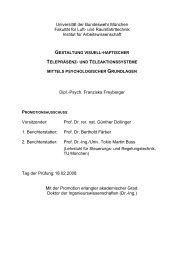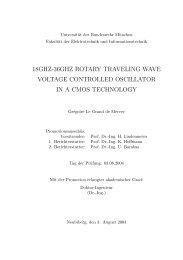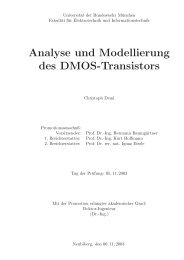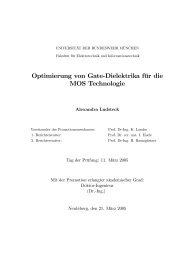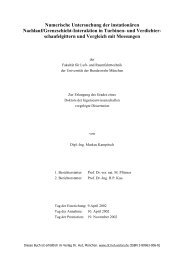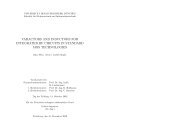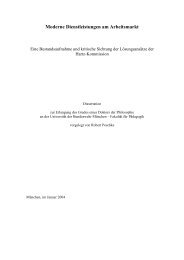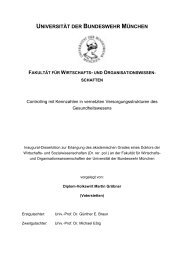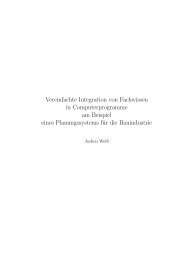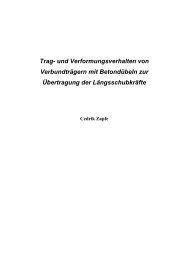Precise Orbit Determination of Global Navigation Satellite System of ...
Precise Orbit Determination of Global Navigation Satellite System of ...
Precise Orbit Determination of Global Navigation Satellite System of ...
Create successful ePaper yourself
Turn your PDF publications into a flip-book with our unique Google optimized e-Paper software.
Chapter 7 <strong>Orbit</strong> <strong>Determination</strong> Using Carrier Phase Observation<br />
The observation equation Eq.(7-2) can be used with Kalman filter or batch processing to determine the satellite<br />
orbit. The advantage is that there are no initial ambiguities in Doppler measurements. Due to slow changes <strong>of</strong> the<br />
line-<strong>of</strong>-sight between tracking station and GEO satellite, it is difficult to determine a GEO satellite orbit using<br />
Doppler observations. This problem will be further shown in §7.2.2.<br />
7.1.3 Effects <strong>of</strong> Initial Ambiguities on <strong>Orbit</strong> <strong>Determination</strong><br />
Initial ambiguities will affect the accuracy <strong>of</strong> satellite orbit determination, which can be evaluated below.<br />
Rewriting Eq.(7-1):<br />
2 2 2<br />
i i i i i<br />
ρ = ( x − x) + ( y − y) + ( z − z) + λN<br />
Differentiating Eq.(7-3),<br />
1<br />
∆ρi = [( xi − x) ∆x+ ( yi − y) ∆y+ ( zi − z) ∆z] + λ∆Ni<br />
(7-4)<br />
ρ′<br />
where,<br />
2 2 2<br />
i i i<br />
ρ ′= ( x − x) + ( y − y) + ( z −z)<br />
Assuming that the accuracy <strong>of</strong> ∆x, ∆y, ∆z<br />
are equal and ∆ρ = 0 . The vectors<br />
ϖ ϖ ϖ ϖ<br />
r = xi + yj + zk �<br />
ϖ ϖ ϖ ϖ ��<br />
ri = xii + yij + zik �<br />
ϖ ϖ ϖ�<br />
∆r = ∆xi + ∆yj + ∆zk��<br />
Then Eq.(7-4) becomes<br />
λN<br />
i<br />
ϖ ϖ ϖ ϖ ϖ ϖ<br />
( r − r r r r r θ<br />
i ) ∆ − i ∆ cos<br />
= ϖ ϖ = ϖ ϖ<br />
r − r r − r<br />
i<br />
letting θ=0, Eq.(7-6) can be written as<br />
λN r<br />
i =∆ϖ<br />
i<br />
86<br />
(7-3)<br />
ϖ ϖ<br />
r, ri and ∆ ϖ r can be expressed as<br />
Eq.(7-7) shows the influence <strong>of</strong> initial ambiguity on the accuracy <strong>of</strong> orbit determination. Using GPS L1<br />
frequency as an example, one cycle error in the initial ambiguity will cause 0.19 meter error in satellite orbit.<br />
7.1.4 Kalman Filter for <strong>Orbit</strong> <strong>Determination</strong> using Carrier Phase Observation<br />
Using the Kalman filter and carrier-phase observations to determine IGSO, GEO and MEO satellite orbits, the<br />
initial ambiguities should be included as system parameters in the satellite dynamical model or as non-random<br />
parameters in observation equations. The float solutions are obtained as Kalman filter processes the incoming<br />
observations. In order to fix the float ambiguities to integers, it is necessary to take special strategies such as bias<br />
optimizing (Blewitt, 1989), LAMBDA (Teunissen 1994 and Jonge et al, 1996), TCAR (Harris, 1996 and Forssell<br />
et al 1997), etc..<br />
Assuming that the state variance is ϖ x = {, x y, z,&, x y&, z&, N1, N2, N3 ,..., Nn} in which n is the number <strong>of</strong> tracking<br />
stations, the satellite movement equation has a following form,<br />
� f1<br />
�<br />
ϖ<br />
�<br />
dx<br />
f �<br />
ϖ<br />
= f x t t = � 2<br />
[ ( ), ] �<br />
dt<br />
�...<br />
�<br />
� �<br />
� fn �<br />
(7-5)<br />
(7-6)<br />
(7-7)<br />
(7-8)



